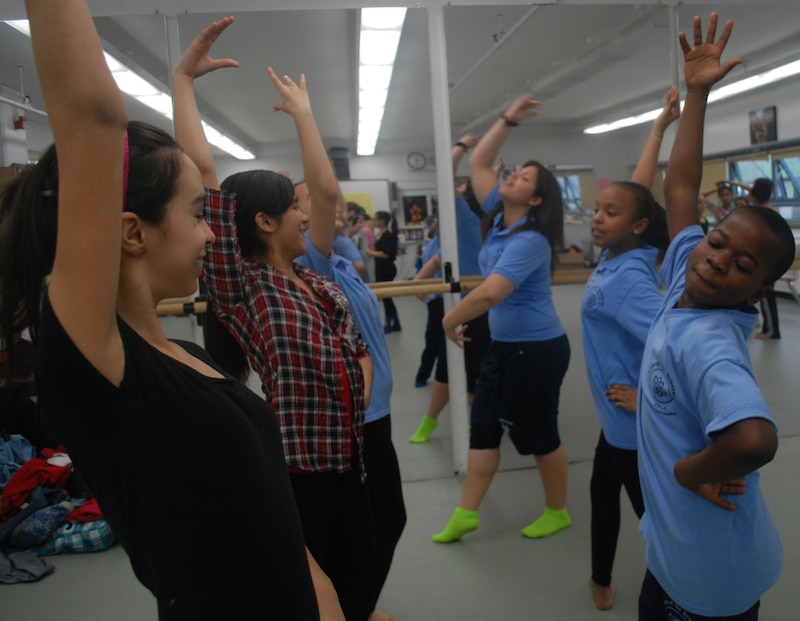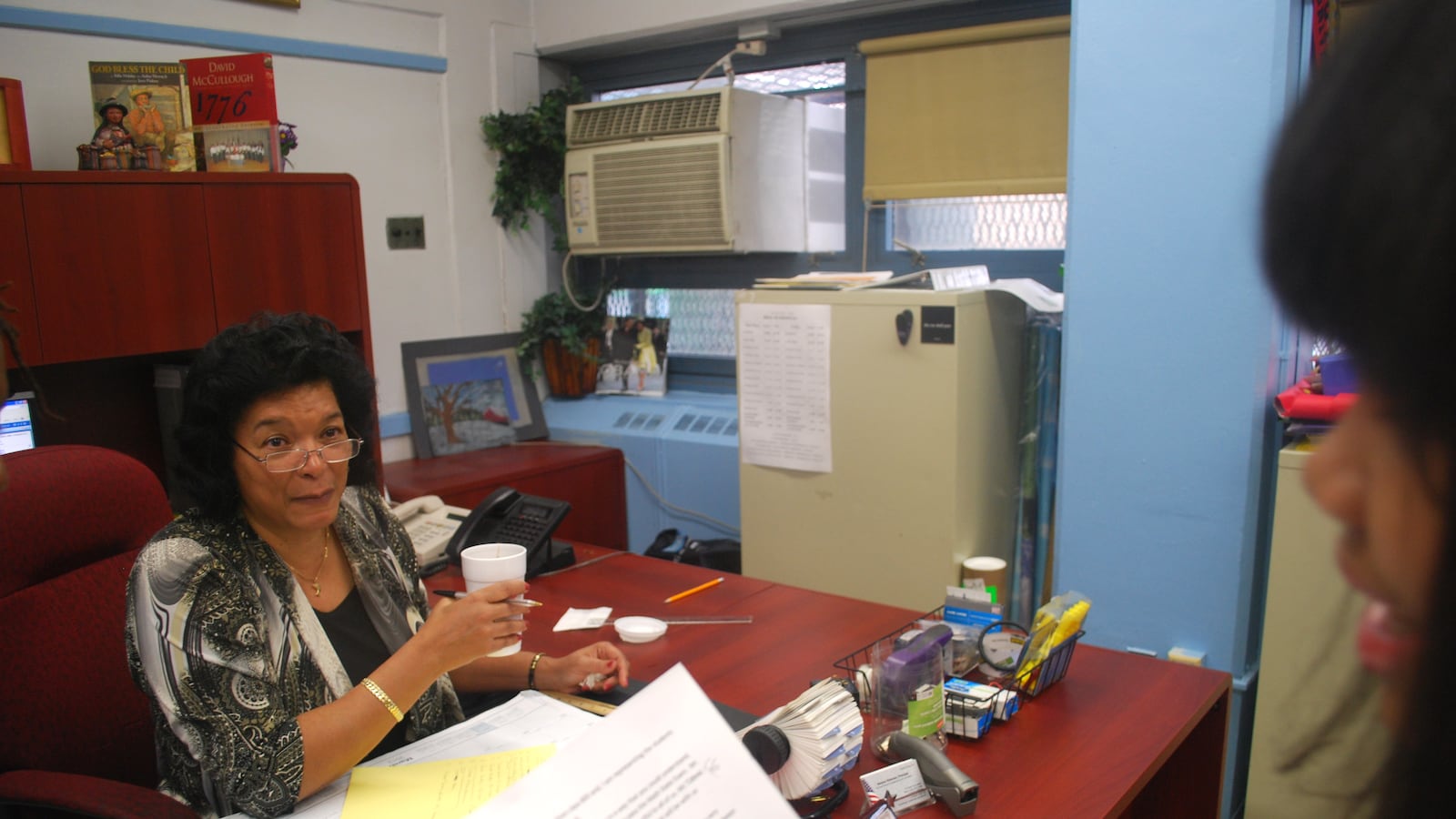Two years ago, Omarina Cabrera’s academics were a distant concern. Her family had been evicted and Cabrera was uncertain where she’d be sleeping each night. And as her brothers descended deeper into the gangs they recently joined, Cabrera was not even sure if she felt safe moving back in with her family.
Months into her sixth-grade year, Cabrera was showing up late to school and teachers were noticing that her attitude seemed to be worsening.
But admission letters pinned to a bulletin board located in the main office of the New School for Leadership and Journalism, where Cabrera is now an eighth-grader, shows that she now has a bright future. Years after teachers intervened to help Cabrera, she received offers to attend top public and private schools in the city, including Brooklyn Technical High School, and boarding schools throughout New England.
Most students at the Kingsbridge school, also known as M.S. 244, don’t wind up at posh boarding schools. Ninety percent of the students come from families so poor that they qualify for free or reduced lunch, and 70 percent come from homes that speak a language other than English. Many struggle to pass state math and reading tests.
But the school’s ability to catch students such as Cabrera before they are lost has caught the Department of Education’s attention. As part of a high-profile initiative to solve entrenched troubles of the city’s middle schools, officials there are directing a group of schools to replicate M.S. 244’s successful implementation of an early warning system to identify and intervene with at-risk students.
The approach is in some ways at odds with the city’s at-times single-minded focus on academic achievement — which is exactly why it works, according to Principal Dolores Peterson.
“The reason we’re successful is that we’ve made it our mission to address the need of the whole child,” said Peterson. “You have to deal with adolescent social issues and emotional issues, not just the academic issues.”
Calvin Hastings, until last year M.S. 244’s network leader, is heading the department’s Middle School Quality Initiative. The $3.7 million program, part of the broader middle school reforms, seeks to reform — rather than close — 18 schools once identified as among the worst in the city. The city culled the schools from a list of 51 that were part of a 2008 City Council initiative — never fully supported by the city — that Chancellor Dennis Walcott has vowed to reinvigorate as part of his much-publicized middle school reforms.
Walcott didn’t mention Peterson’s school in a speech about the middle school reforms last month. But so far, it is the only “anchor school” selected to share best practices with the rest of the group.
At M.S. 244, a committee of deans, counselors, and teachers meets each week to pore over data linked to student progress, not all of which can be found on a bubble sheet. Using a Google Doc spreadsheet that is based on a color-coded “stoplight” system, the school looks at trends in attendance, behavior, and grades in English and math.
Those four categories are what John Hopkins University researcher Robert Balfanz found to be the most crucial indicators for sixth-grade students. If students begin to fall behind in any of the four categories, he found, they are dramatically more likely to drop out of high school.
As Balfanz himself admits, the system does’t actually fix what ails struggling schools. Instead, it is meant to key school leaders into students’ problems before they grow debilitating — or even obvious.
“It’s one thing to flag kids for attendance and behavior issues,” Balfanz said. “But now we have to actually do something about it.”
Peterson said she already had in place the necessary ingredients to effectively use Balfanz: A strong culture — exemplified by tight discipline, uniforms, and an extended day program — is nurtured by an experienced staff, including a core who came to the school with her when she founded it in 2006. The school also employs three counselors who worked with parents to intervene when students had trouble and gave support to teachers.

The staff, in turn, credits Peterson for the school’s success.
“So much of what makes this school successful begins with our culture, which begins with the leadership,” said Sharrone Usher, a counselor who helped found the school.
Peterson said the Balfanz model has helped make M.S. 244’s monitoring more organized, allowing her to see know precisely what’s going on behind the scenes when an indicator is flagged. Before, school officials didn’t know precisely how many students needed help, why they needed it, or how they did once they received assistance.
Now, they have a much better idea.
Since Peterson implemented the Balfanz model at her school three years ago, 100 students have been identified as “most at risk” and triggered aggressive intervention plans. Twelve of the 30 students in the first cohort tracked under the Balfanz model are no longer failing after being flagged as at risk in sixth grade. All six students who were flagged for chronic absenteeism have lifted their attendance rate above 90 percent. Eight students left and two joined gangs, including Cabrera’s twin brother.
Academically struggling students usually follows a prescribed intervention along the lines of lunchtime tutoring and enrollment in the school’s extended learning programs and Saturday school.
For more severe issues that the model turns up, teachers say they pursue more aggressive interventions.
When Marques Samuels stopped handing in work, his English teacher, Kathy Dahdal, showed up at his house and tersely explained to his grandmother that he would be held back if he didn’t start working.
Now Samuels proudly carries around a writing portfolio that chronicles his progress in Dahdal’s class, where he is no longer failing.
“Ms. Dahdal is very persistent,” said Samuels, who will attend the Bronx Engineering and Technology Academy next year.
The school doesn’t just target students with failing grades. The indicators often flag students before the problem gets so severe.
Cabrera was never one of the “most at risk” students, but her attendance issues showed up in the data early on in sixth grade. Teachers also began to notice that Cabrera’s demeanor change from cheerful to withdrawn.
Once they learned of her plight at home, they took an “all hands on deck” approach to helping her, Peterson said. That included rides home and gift baskets. Cabrera was challenged academically as well. Cabrera’s English teacher, Catherine Miller, pushed her to enroll in a more rigorous after-school program with older students. Miller also became a kind-of personal admissions consultant, helping her prep her for the city’s high school admissions exams and navigate the lengthy applications for top-notch private and public high schools.
Cabrera said she was at first ashamed to speak about her personal problems.
“But they had noticed me,” Cabrera said on a recent morning at a conference table located in Peterson’s office. “And that was something like, wow, they know me. I’m not just a student to them. They actually care for me and that’s something I didn’t know before.”

